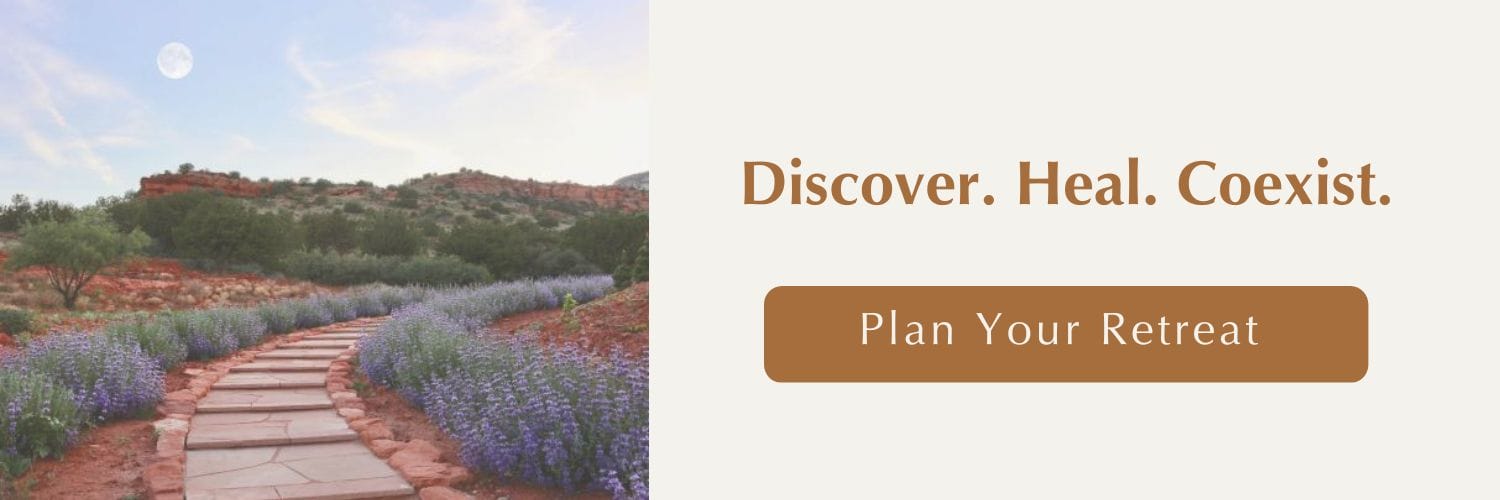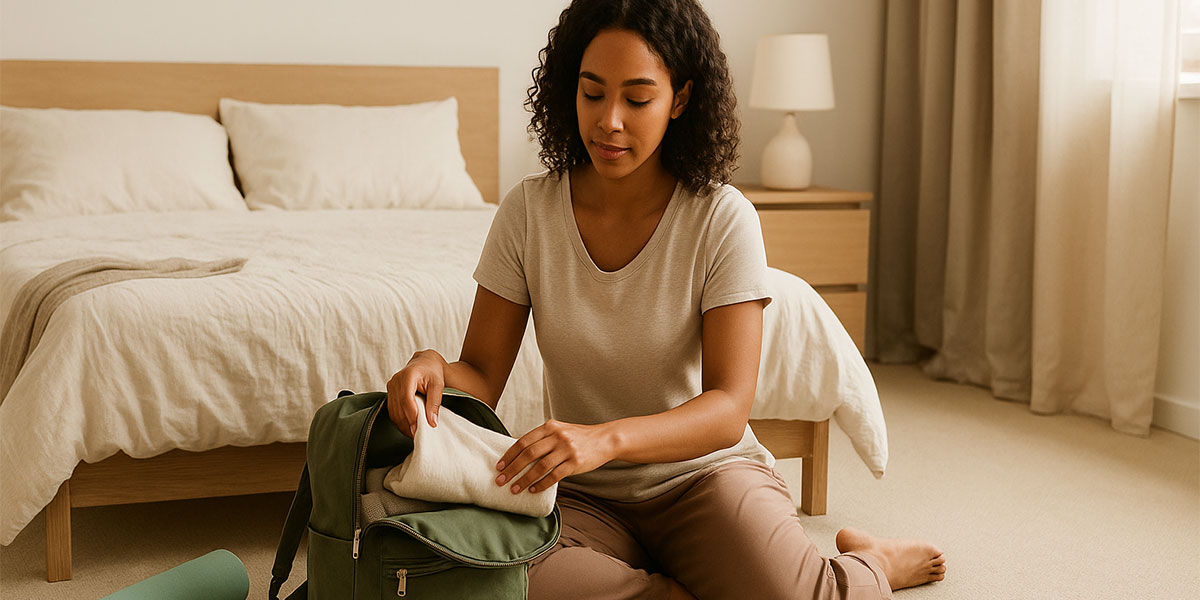How To Tell If Your Chakras Are Blocked: Physical, Emotional, and Spiritual Symptoms
Do you sometimes experience physical or emotional symptoms that don’t seem to have a clear cause? Maybe you’ve been trying to make sense of why you feel off — fatigued, anxious, disconnected — but nothing quite adds up. Many people are going through the same, and we understand how overwhelming that can feel.
It’s easy to start doubting yourself when you can’t find an obvious explanation, but learning about chakras and their blockage symptoms can give you a powerful tool to address whatever is going on with your energy.
In this article, we’ll walk you through the most common signs that one or more of your chakras may be blocked. You’ll learn how to identify the source of the imbalance and begin exploring practical, supportive ways to bring your energy back into alignment.
Table of Contents
- What Are Chakras?
- What Does It Mean for Chakras To Be Blocked?
- 7 Chakras and Their Physical, Emotional, and Spiritual Symptoms
- Balance Your Chakras Through Movement, Breath, and Energy Practices at Sedona Mago Center for Well-Being & Retreat
What Are Chakras?
Chakras, meaning “wheels” in Sanskrit, are considered the main energy points in the body, aligned along the spine from the base to the crown of the head. Rooted in ancient Indian philosophy and first referenced in the Vedas over 3,000 years ago, chakras are often described as spinning centers of energy that may influence how you feel physically, emotionally, and energetically.
Each chakra is believed to correspond to different aspects of your physical, emotional, and energetic experience. When functioning well, they may support a sense of balance and ease.
While some systems describe dozens of chakras, there are seven main ones most people focus on:
- Root: (Red) Located in the tailbone area
- Sacral: (Orange) Below the belly button, above the pubic bone
- Solar Plexus: (Yellow) In the stomach area
- Heart: (Green) At the center of the chest
- Throat: (Blue) In the throat area
- Third Eye: (Purple) Between the eyes, on the forehead
- Crown: (Violet or white) At the very top of the head
What Does It Mean for Chakras To Be Blocked?
When people talk about a chakra being “blocked,” they’re usually referring to an imbalance in how energy moves through that part of the body. Because the seven main chakras are interconnected, a disruption in one area may influence others as well.
At Sedona Mago Center for Well-Being & Retreat, our programs are designed to help you tune into those signals and build greater awareness of how your energy flows so you can respond with intention.
What Are the Symptoms of a Blocked Chakra?
Because each chakra relates to a different part of the body and aspect of your emotional or energetic experience, the signs of blockage may show up in different ways.
7 Chakras and Their Physical, Emotional, and Spiritual Symptoms
1. Root Chakra
The root chakra, or Muladhara, is located at the base of the spine and is considered the foundation of the chakra system. It’s associated with your sense of safety, stability, and basic needs, like food, shelter, financial security, and your connection to the physical world.
Physical Symptoms
If the root chakra is blocked, you may experience fatigue, sluggishness, or physical tension in the legs, feet, or lower back.
Emotional Symptoms
An imbalanced root chakra can lead to chronic fear, anxiety around money or survival, a deep sense of not belonging, and feeling stuck, often accompanied by constant stress from heavily relying on external circumstances.
Blockage Symptoms
When the root chakra is blocked, you might feel ungrounded, as if you’re floating through life without direction or struggling to feel safe in your body or circumstances. This may also manifest as a lingering sense of abandonment by your parents or guardians.
Openness Symptoms
When this chakra is balanced, people often feel secure, supported, and at home in themselves. You feel like you are enough, exactly as you are.
2. Sacral Chakra
The sacral chakra, or Svadhisthana, is located just below the navel and is closely tied to your emotional world, creativity, pleasure, and relationships. It represents your ability to experience joy, express desire, and connect with others without guilt or shame.
Physical Symptoms
When the sacral chakra is out of balance, you may notice tension or discomfort in the hips, lower abdomen, or reproductive organs.
Emotional Symptoms
An imbalanced sacral chakra may make it difficult to form deep connections, cause struggles with vulnerability, or lead to feelings of unworthiness when it comes to love and affection.
Blockage Symptoms
You might feel disconnected from joy or believe that pleasure — both emotional and physical — is something you have to earn, often accompanied by lingering feelings of abuse, resentment, or uncertainty.
Openness Symptoms
When the sacral chakra is balanced, creativity flows more freely, relationships feel authentic, and joy becomes more accessible.
3. Solar Plexus Chakra
The solar plexus chakra, or Manipura, is located in the upper abdomen and is associated with your sense of self — your personal power, confidence, and ability to make decisions that align with who you are. This chakra governs how you see yourself and how you step into your life with purpose and strength.
Physical Symptoms
When the solar plexus chakra is blocked, you may experience digestive discomfort, tension in the upper abdomen, or a general feeling of unease.
Emotional Symptoms
If there’s a blockage in the solar plexus, you might struggle with self-doubt, feel like a passenger in your own life, or hesitate to pursue your goals. You may give your power away to avoid conflict.
Blockage Symptoms
This blockage may show up as a lack of direction or a tendency to look outside yourself for validation and answers. You may find yourself feeling powerless or victimized.
Openness Symptoms
When energy flows freely through the solar plexus chakra, you’re more likely to feel confident in your choices, grounded in your worth, and motivated to take action.
4. Heart Chakra
The heart chakra, or Anahata, is located at the center of the chest and represents love, compassion, emotional balance, and the connection between the physical and spiritual self. This chakra is about how you give and receive love, not just with others, but with yourself.
Physical Symptoms
When the heart chakra is imbalanced, you may feel tension in the chest, experience shortness of breath, or notice discomfort in the upper back and shoulders.
Emotional Symptoms
If the heart chakra is blocked, you might struggle with trust, feel guarded in relationships, or believe that you have to earn love by pleasing others.
Blockage Symptoms
When the heart chakra is not flowing properly, it may feel harder to forgive yourself or others or to let go of past pain that’s keeping your heart closed.
Openness Symptoms
When this chakra is open, love feels more effortless and expansive. Feel honest gratitude for everything in your life.
5. Throat Chakra
The throat chakra, or Vishuddha, is located at the center of the throat and is considered your communication center. It governs your ability to express yourself clearly and honestly — whether that’s through speaking, writing, or creative expression. This chakra is closely tied to your inner truth and the confidence to share it.
Physical Symptoms
A blocked throat chakra may cause sore throats, tension in the neck or jaw, or a persistent sensation of tightness in the throat.
Emotional Symptoms
When the throat chakra is not balanced, you may find yourself holding back your thoughts or going along with others just to keep the peace, even when it doesn’t feel right.
Blockage Symptoms
If your throat chakra is blocked, it can feel like your voice doesn’t matter, or that it’s safer to stay silent than to speak your truth.
Openness Symptoms
When the throat chakra is balanced, it becomes easier to express yourself with clarity and courage. You may notice people even listening to you.
6. Third Eye Chakra
The third eye chakra, or Ajna, is located between the eyebrows and is associated with intuition, self-reflection, and a deeper sense of life direction. Often called the center of inner knowing, this chakra supports your ability to visualize, discern, and trust your inner guidance.
Physical Symptoms
A blockage in the third eye may cause frequent headaches, tension in the forehead, or eye strain.
Emotional Symptoms
If your third eye is unbalanced, you might feel uncertain about your path, question your purpose, or feel disconnected from your sense of direction.
Blockage Symptoms
Blockage in this chakra can show up as a lack of clarity or difficulty accessing your own inner wisdom. You may struggle to make decisions.
Openness Symptoms
When energy flows through the third eye chakra, it becomes easier to trust your inner voice and feel aligned with your intentions. Inner wisdom and clarity are evident.
7. Crown Chakra
The crown chakra, or Sahasrara, is located at the top of the head and is often described as your center for spiritual connection. It’s associated with your belief systems, sense of purpose, and relationship to something greater than yourself — whether that’s defined through religion, nature, or inner consciousness.
Physical Symptoms
When the crown chakra is blocked, you may experience migraines, tension headaches, or a sense of pressure at the top of the head.
Emotional Symptoms
An unbalanced crown chakra may also lead to feeling isolated, lost, or unsure of your place in the world, or a strong attachment to material possessions.
Blockage Symptoms
Crown chakra blockage can show up as being disconnected from your values, questioning your beliefs, or feeling abandoned by any guiding presence.
Openness Symptoms
When the crown chakra is balanced, there’s often a quiet sense of trust in something larger than the self.
Balance Your Chakras Through Movement, Breath, and Energy Practices at Sedona Mago Center for Well-Being & Retreat
Balancing your chakras isn’t about perfection — it’s about awareness.
At Sedona Mago Center for Well-being & Retreat, our Chakra Healing Retreat is designed to help you tune into your body, notice where energy may feel stuck, and gently guide it back into flow.
Does this sound like the way you’d like to regain stability in your energy points? Let us teach you how to do it! Through intentional movement, breathwork, and energy practices rooted in Sun Tao principles, you may feel more present, centered, and connected to yourself.
Whether you’re just starting to explore the chakra system or deepening an existing practice, Sedona Mago retreats offer a supportive space to grow at your own pace and in your own way.
Recent Posts





